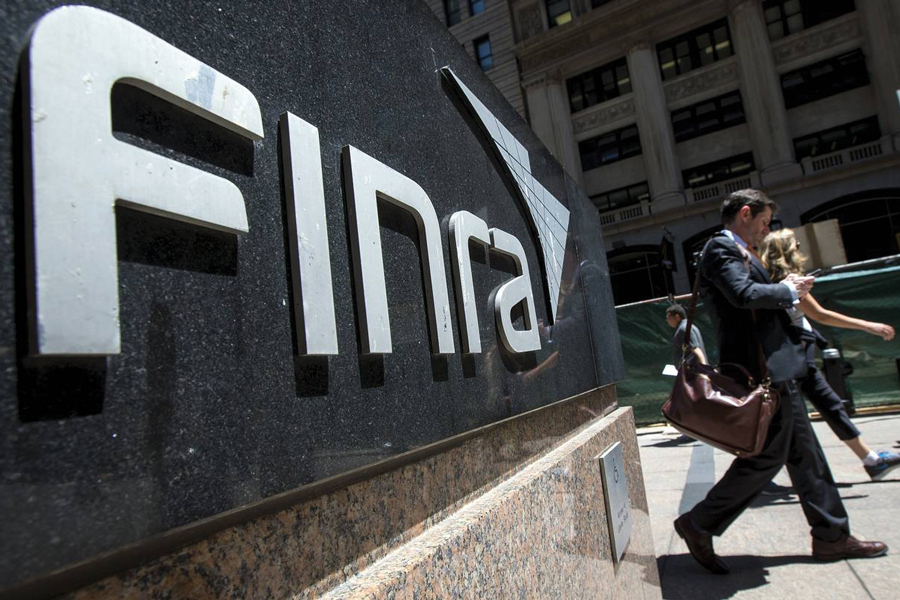

Finra achieved a $19.8 million profit in 2020, a sharp turnaround from its $45.9 million loss in 2019 that was driven in large part by the revenue generated from the trading activity and income of its member firms.
The Financial Industry Regulatory Authority Inc. recorded $1.1 billion in operating revenue last year while collecting $57 million in fines for $1.16 billion in net revenue, according to its 2020 annual financial report. Both numbers represented gains from 2019, when the broker-dealer self-regulator showed $899 million in operating revenue and assessed $39.5 million in fines.
“Higher operating income for the year reflected increased revenues, due primarily to higher trading volumes and a large number of public offerings, partially offset by an increase in operating expenses and lower interest and dividend income,” Finra chief executive Robert W. Cook wrote in a letter accompanying the financial report.
More than 90% of Finra’s regulatory revenue of $127.8 million was attributable to higher trading activity fees, according to the report. The organization’s gross income assessment on its member firms also contributed to the boost in its revenue from industry oversight.
“Volume increases due to market volatility during the Covid-19 pandemic drove the increase in TAF,” the report states. “The remainder of the increase was driven by higher GIA, due to an increase in industry revenues.”
Finra’s expenses rose to $1.16 billion in 2020, up from $1.095 billion in 2019. The increase was driven by the organization’s expanded use of cloud computing services and an increase in computer software subscriptions as well as an increase in professional and contract services related to its work as the plan processor for the Consolidated Audit Trail system.
Compensation and benefits expenses dropped by $22.5 million due to lower insurance costs, incentive pay and severance expenses. But Finra’s total employment grew to approximately 3,600 in 2020 from 3,400 in 2019.
“Staff increases related to our regulation and technology functions drove the year-over-year increase in employees,” the report states.
Finra’s interest and dividend income fell to $23.4 million last year from $32.9 million in 2019. Its investment gains were $3.9 million in 2020 compared to $90.9 million in 2019.
“Finra’s reserve portfolio provided a 1.2 percent return in 2020 compared to a 6 percent return in 2019,” the report states.
Finra had $1.5 billion in net assets — its reserve fund — as of the end of 2020.
Cook reiterated in his letter that Finra does not plan to raise membership fees in 2021, the eighth consecutive year in which fees have not increased.
“Our financial plans for future years — which include continuing to strategically draw down on excess reserves in order to support FINRA’s operations, while phasing in a delayed fee increase over several years — have been discussed extensively in previous financial reports, a 2020 regulatory filing with the SEC, and a communication to member firms last year,” Cook wrote.
The report shows that Cook earned $3.1 million in 2020. Other top Finra executives who earned more than $1 million last year were Todd T. Diganci, executive vice president and chief financial officer; Steven Randich, executive vice president and chief information officer; Robert L.D. Colby, executive vice president and chief legal officer; and Bari Havlik, executive vice president for member supervision.
Finra also said in its financial report that last year it conducted 5,623 exams and reviews, returned $25.2 million to harmed investors, expelled two firms, barred 246 brokers and suspended 375 brokers.
The organization regulated 3,435 brokerages and 617,549 registered representatives at the end of last year.

Relationships are key to our business but advisors are often slow to engage in specific activities designed to foster them.

Whichever path you go down, act now while you're still in control.

Pro-bitcoin professionals, however, say the cryptocurrency has ushered in change.

“LPL has evolved significantly over the last decade and still wants to scale up,” says one industry executive.

Survey findings from the Nationwide Retirement Institute offers pearls of planning wisdom from 60- to 65-year-olds, as well as insights into concerns.
Streamline your outreach with Aidentified's AI-driven solutions
This season’s market volatility: Positioning for rate relief, income growth and the AI rebound
